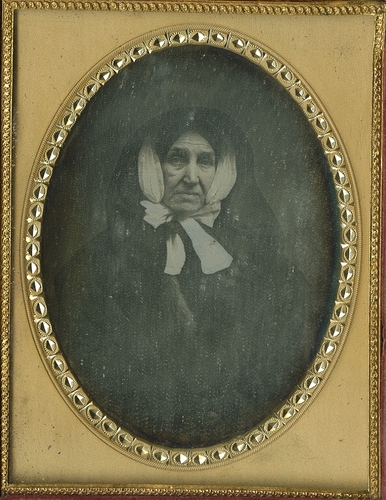 |
| |
Unidentified photographer
Jean McAra Walker in Mourning Dress
[The Gift of Anne Baker in Memory of the Walker Family]
1854-1855
Daguerreotype
New Brunswick Museum
Accession number: 2021.17.9
LL/120590
A Major Gift of Late Georgian and Early Victorian New Brunswick Portraiture - The Gift of Anne Baker in Memory of the Walker Family, 2 May 2022, New Brunswick Museum
In 2021, the New Brunswick Museum (NBM) received an extremely important collection of late Georgian and early Victorian provincial portraiture. Thanks to the generosity of Anne Baker, Saint John, NB, a group of bronze medallions, portrait miniatures and early cased photographs has added significant content to one of the finest museum collections in Canada. This group of objects relates to a prominent New Brunswick family. Dr. Thomas Walker (Perth, Scotland 1783 – Saint John, NB, 27 October 1852), a surgeon in the 40th Regiment of the British army, and Jean McAra Walker (Largs, Scotland, 1789 – Saint John, NB, 27 January 1858) were the parents of four children: John McAra (1814, West Indies – Halifax, NS, 2 March 1877), Thomas Jr. (16 August 1818 – Bury, St. Edmund’s, England, 13 June 1860), Agnes (Saint John, NB, 1821 – Saint John, NB, 4 July 1828) and James (Saint John, NB, 21 December 1829 – Saint John, NB, 14 January 1914). Dr. Thomas Walker had been stationed in England and in the West Indies where he and Jean McAra married. The young family moved to Halifax, NS, and a few years later, in about 1820, to Saint John, NB, where Dr. Walker practiced medicine for about thirty years and their son, James Walker, also became a medical doctor. The Walkers were among the many educated and professional Scottish immigrants who arrived in New Brunswick in the early 19th century and who had a profound effect on the culture and heritage of the province.
…
The remaining items in this collection are a group of fifteen early photographs – cased daguerreotypes and ambrotypes. These items are in their original, hinged wooden cases covered with leather or embossed paper and lined with silk satin or velvet. These photographs are very fragile. The daguerreotypes were made using mercury vapours to create an image on a copper plate covered with a layer of polished silver and the ambrotypes were made using a wet collodion emulsion on a piece of glass. The NBM houses approximately 250 examples of early, cased photographs making it one of the most extensive collections in the region. For the most part, these images record the same members of the Walker family in addition to other relatives. Some of these items are specifically dated and a few are identified as having been taken in Halifax, NS. It is interesting to note that in 1846, Robert Foulis entered into a partnership with James Godfrey Melick (1802-1885) a Saint John clockmaker, to operate a daguerreotype studio over Melick’s shop. It is even possible that some of the early daguerreotypes in this collection were taken by Foulis & Melick. It is also possible that some of the daguerreotypes were taken by William Valentine (1798-1849), an itinerant artist, miniature painter and daguerreian based in Halifax, NS, who introduced the Maritimes to photography. In November 1841, he advertised the new art form in Saint John, NB, on his way back home to Nova Scotia. Especially poignant are the photographs of Dr. Thomas Walker in later life and the likeness of Jean McAra Walker dressed in deep mourning after his death in early 1852. Nonetheless, these early photographs, and those definitely identified members of the Walker family are an excellent chronicle of the introduction and early years of photography in the province. In addition to providing high quality examples of early photographic techniques, the images show changing fashions. The various presentation methods also cover a variety of cased photography production in the early years of this art form in the province. They are very useful comparatives in the analysis of the existing collections as well as for other research inquiries and publication.
| |
|
|

